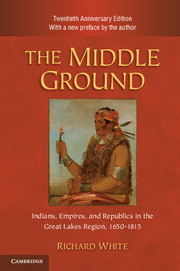Book contents
- Frontmatter
- Contents
- List of abbreviations
- Preface to the twentieth anniversary edition
- Introduction
- 1 Refugees: a world made of fragments
- 2 The middle ground
- 3 The fur trade
- 4 The alliance
- 5 Republicans and rebels
- 6 The clash of empires
- 7 Pontiac and the restoration of the middle ground
- 8 The British alliance
- 9 The contest of villagers
- 10 Confederacies
- 11 The politics of benevolence
- Epilogue: Assimilation and otherness
- Index
Epilogue: Assimilation and otherness
Published online by Cambridge University Press: 05 June 2012
- Frontmatter
- Contents
- List of abbreviations
- Preface to the twentieth anniversary edition
- Introduction
- 1 Refugees: a world made of fragments
- 2 The middle ground
- 3 The fur trade
- 4 The alliance
- 5 Republicans and rebels
- 6 The clash of empires
- 7 Pontiac and the restoration of the middle ground
- 8 The British alliance
- 9 The contest of villagers
- 10 Confederacies
- 11 The politics of benevolence
- Epilogue: Assimilation and otherness
- Index
Summary
In different ways, both Anglo Americans and Algonquians subverted the middle ground in the nineteenth century. The compromises intrinsic in the middle ground yielded to stark choices between assimilation and otherness. Americans made Tecumseh and Tenskwatawa into symbols of the alternatives. Tecumseh, the paradoxical nativist who had resisted the Americans, became the Indian who was virtually white. He had, as his first American biographer put it, risen “above the prejudices and customs of his people.”
The remaking of Tecumseh and his assimilation into the mythology of Anglo-American society took its most enduring and revealing form in the Rebecca Galloway story. In that legend, Tecumseh, dark and black-haired, falls in love with the blond, blue-eyed Rebecca. She reads to him from the Bible and from Shakespeare and tells him of world history. Tecumseh learns of Moses, Hamlet, and Alexander the Great – figures to whom his Anglo-American opponents will later compare him. Tecumseh asks Rebecca to marry him, and she accepts, but only on the condition that he give up his life as an Indian and adopt her people's “mode of life and dress.” He sadly refuses. They never meet again.
The Galloway story – still retold each summer as part of a tourist pageant at Chillicothe, Ohio – “explains” Tecumseh by explaining how a man of such vision, such virtue, such overarching abilities, and such keen intelligence arose among “savages.”
- Type
- Chapter
- Information
- The Middle GroundIndians, Empires, and Republics in the Great Lakes Region, 1650–1815, pp. 518 - 524Publisher: Cambridge University PressPrint publication year: 2010



